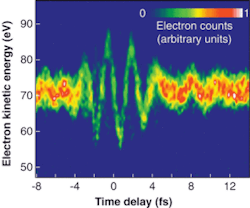‘Oscilloscope rendering’ of light is achieved
While the frequencies of radio (megahertz range) and microwaves (gigahertz range) allow them to be simply observed as an oscilloscope trace, the frequency of visible light hovers at around 1015 Hz, or 10,000 times higher than the most sensitive electronic instruments can measure. This subfemtosecond oscillation would require an oscilloscope with a temporal resolution of several hundred attoseconds (1 attosecond = 10-18 s). Now, a technique has been developed by physicists at the Max Planck Institute of Quantum Optics (Garching, Germany), the University of Bielefeld (Bielefeld, Germany), and the Vienna University of Technology (Vienna, Austria) that can measure the instantaneous change in the electric field of a 750-nm visible laser pulse (with a period of 2.5 fs) to a resolution of 100 attoseconds.1
Electrons probe visible light
This measurement of the actual oscillation of visible light was made possible by a breakthrough earlier in the year from the same research team-the ability to generate an ultrafast 250-attosecond extreme-UV laser burst.2 The UV burst is created when an intense linearly polarized laser pulse knocks electrons free from a gas of neon atoms. This pulse is then localized to free more electrons that are then accelerated or decelerated by the laser pulse to reveal an “oscilloscope rendering” of the laser’s classical electric field.
By definition, the electric field of a light wave is defined as the force exerted on a point charge of unit value. To measure the electric field at a particular moment, given the rapid variation of the electric field as a function of time, a “probe charge” would need to be placed instantly in the field within a time interval over which the temporal variation of the force is frozen-that is, a time period that is much shorter than the period of the light wave itself. The probe has to be localized not only in time to a tiny fraction of the wave period, but also in space to a tiny fraction of the wavelength of light to be measured.
The researchers accomplished this task by ionizing a gas of neon atoms with an intense laser pulse. Linearly polarized, waveform-controlled, 0.4-mJ, 750-nm laser pulses produce 250-attosecond extreme-UV pulses with a mean energy of 93 eV in a 2-mm-thick gas jet of neon atoms. The UV pulses copropagate with the laser pulse in a collinear beam to a second, smaller neon target placed in the focus of a spherical molybdenum/silicon multilayer mirror with a 120-mm focal length.
The focused UV radiation sets electrons free by photoionization. These free electrons probe the laser vector potential, defined laterally by the less-than-10-µm diameter of the ultraviolet beam at its waist and longitudinally by the less-than-50-µm size of the neon jet, which is well-confined within the focal volume of the laser beam. The field-induced variation of the final energy spectrum of the probe electrons versus delay between the UV burst and the laser pulse reveal that probing is implemented by a single burst of subfemtosecond duration that is synchronized to the measured laser field. The result is a kinetic energy spectrum of electrons that mimics the electric field of the 750-nm laser pulse (see figure).
A pulse of 750-nm laser light and a synchronized 250-attosecond extreme-UV burst is focused into an atomic gas of neon atoms. The burst knocks electrons free from the neon atoms by photoionization. The electric field of the laser pulse imparts a momentum change to the freed electrons that scales to the instantaneous value of the electric field of the laser pulse. In false-color representation, the kinetic-energy spectrum of the detached electrons is shown versus the timing of the 250-attosecond UV trigger pulse that launched the probing electrons. The waveform represents an “oscilloscope rendering” of the electric-field characteristics of the 750-nm laser pulse, with clear periodicity of approximately 2.5‑femtoseconds.
With the development of the attosecond photon probe, the research team has ambitious plans. Considering that the electron in a hydrogen atom takes about 150 attoseconds to orbit around the proton, measurement at attosecond speeds opens the door to understanding a world of atomic and molecular processes. Enabled by their steady progression of inventions in the attosecond realm, researcher Matthias Uiberacker and his team are excited about the next phase of their research-the new ability to “resolve ultrafast electron dynamics in atoms or molecules in the time domain for the first time.” For example, the dynamics of photoionization in rare-gas atoms and hydrogen molecules using visible laser pulses.
REFERENCES
1. E. Goulielmakis et al., Science 305, 1267 (Aug. 27, 2004).
2. R. Kienberger et al., Nature 427, 817 (Feb. 26, 2004).

